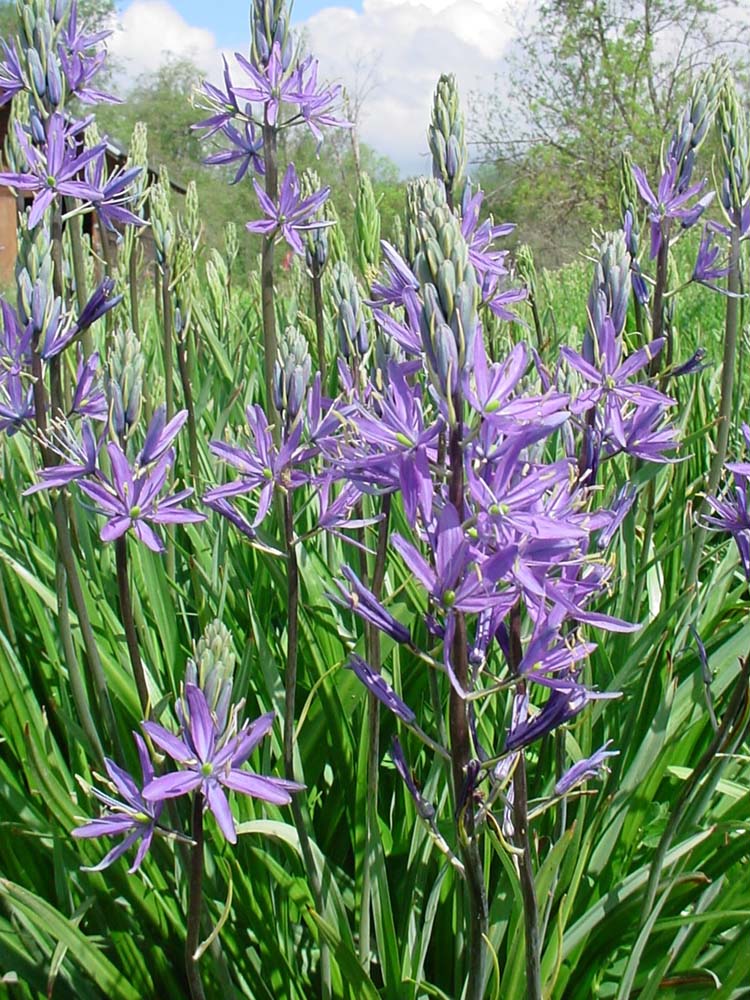
Camas Cook-Out
Ashland, Oregon
April 17-18, 2004

The 2nd Annual Camas Cook-Out took place at North Mountain Park in the City of Ashland where camas patches have been maintained for a number of years. About 20 people met on Saturday morning to learn about the history of camas, dig up camas bulbs, wash and prepare them, and then bake them in a pit oven. The oven was dug out about three feet deep and four feet in diameter. A long wood pole was centered in the hole, so that water could be poured down for steam. The pit was lined with hot rocks and filled with branches, ferns, and rose brambles. Camas and other edibles were placed on this layer and then covered with more vegetation. About 24 hours later the camas was ready to be eaten.
The bake was hosted by City of Ashland Parks and mimicked the Camas bake from the year before. Don Todt and Frank Kenawha Lake led the bake. Interested citizens, local media, students, and park personel participated in the event. Bob Zybach and Nana Lapham from Oregon Websites and Watersheds (ORWW) attended the bake and documented it for this website. The following pictures and videos were taken on-site and show a traditional camas bake process.
Picture Index
From left to right: Don Todt, Luna Latimer, and Frank Lake
Camas Field The camas flowers are a distinctive blueish purple.
Camas Bulbs The bulbs are white and are clustered in clumps. The main bulb will have a tap root and other smaller bulbs will be clustered around it.
Digging Camas Digging camas is easier in areas where it is routinely dug up. The bulbs should be selectively harvested to ensure a plentiful bounty for the next harvest season. Frank referes to camas harvesting as similar to "thinning the stand."
Local News Channel 12 News came out to film the scene while Frank Lake showed the group how to dig up bulbs
Washed Bulbs The bulbs have been washed and peeled and are ready to be cooked. These bulbs are a bit smaller than what an older patch of camas might produce.
Ready to Bake The camas, along with other roots and meats, is ready to be steamed. A pole is centered to pour water into to create steam.
Baking Camas The camas is being covered by vegetation and will cook for about 24 hours.
Waiting The camas is baking and if cooked properly should be starchy, slightly chewy, and sweet.
Video Index
Frank's Digging Stick The digging stick that Frank shows is made out of wood (mahogany and yew wood are ideal) and has a bone (elk or deer antler) handle that can be removed and used as a soil picker.
Digging Camas The camas bulbs are usually situated about six inches under the soil. The smaller bulbs and the main bulb with the central tap root can be replanted to ensure furture harvests. The larger bulbs can be saved and eaten.
Firewood Frank talks about the surrounding landscape and the most likely "wood recruitment area." Driftwood and other downed wood is used for firewood. Hardwood or shrub material doesn't contain a lot of pitch or resin and won't impart a bad flavor.
Heating Rocks Hot rocks and soil are placed in the oven pit, while the outside layer of the camas bulbs are peeled and the skinned bulbs are washed.
Baking Camas The pit is filled with ferns, rose brambles and other vegetation, the camas and other prepared food is layed down and covered with another layer of vegetation. Burlap is placed over that and then is covered by dirt and and hot ash.
© 2004 Oregon Websites and Watersheds Project, Inc.